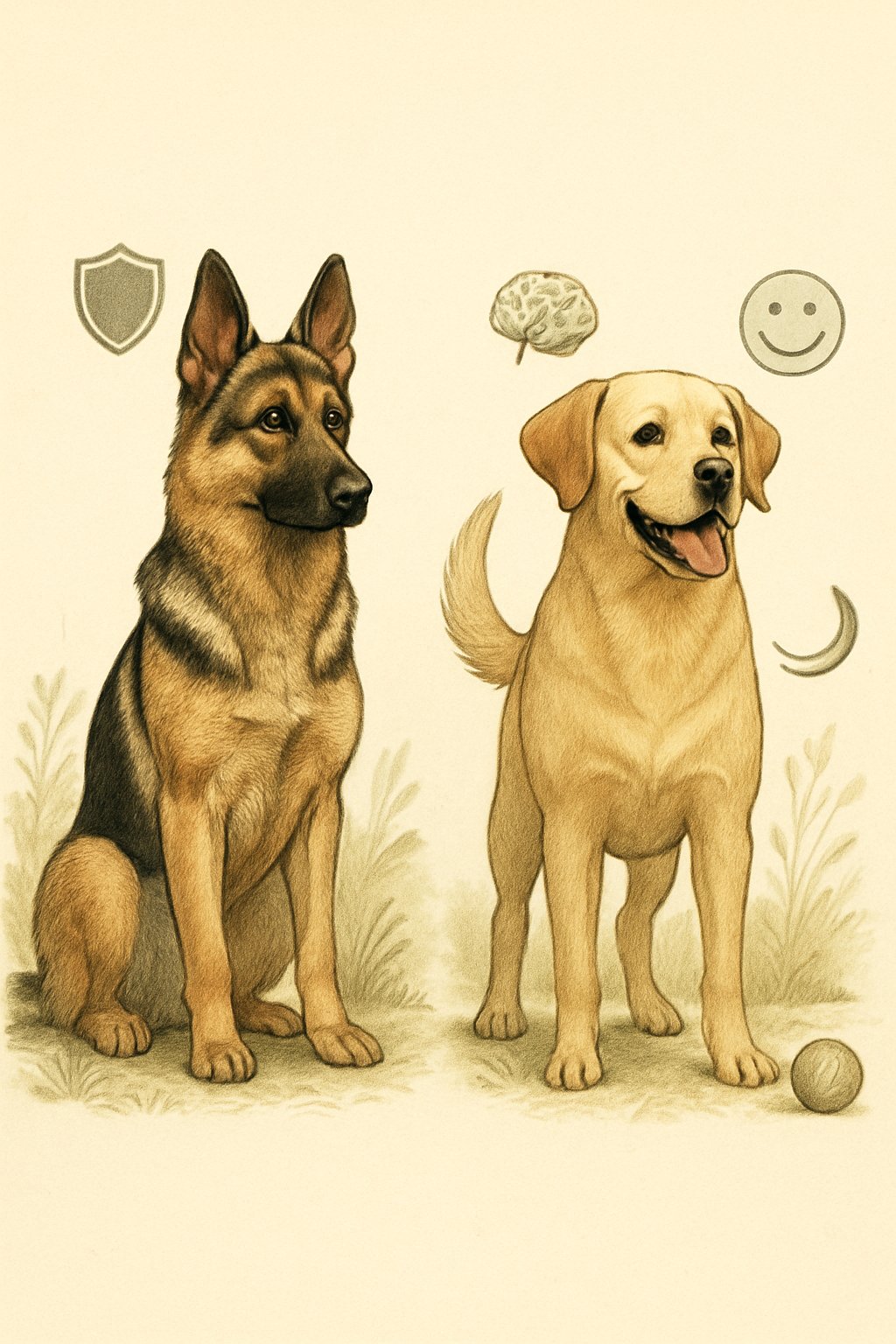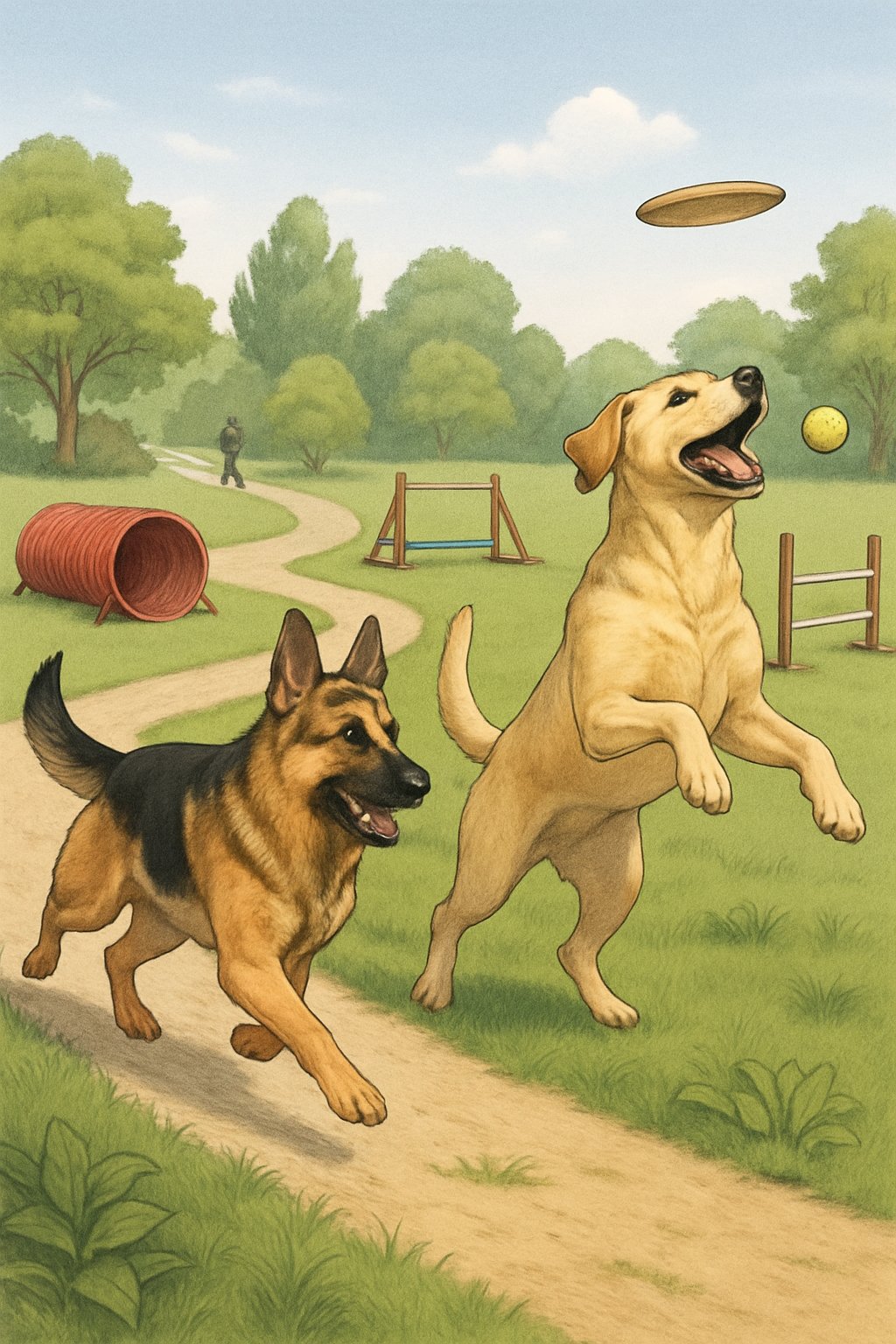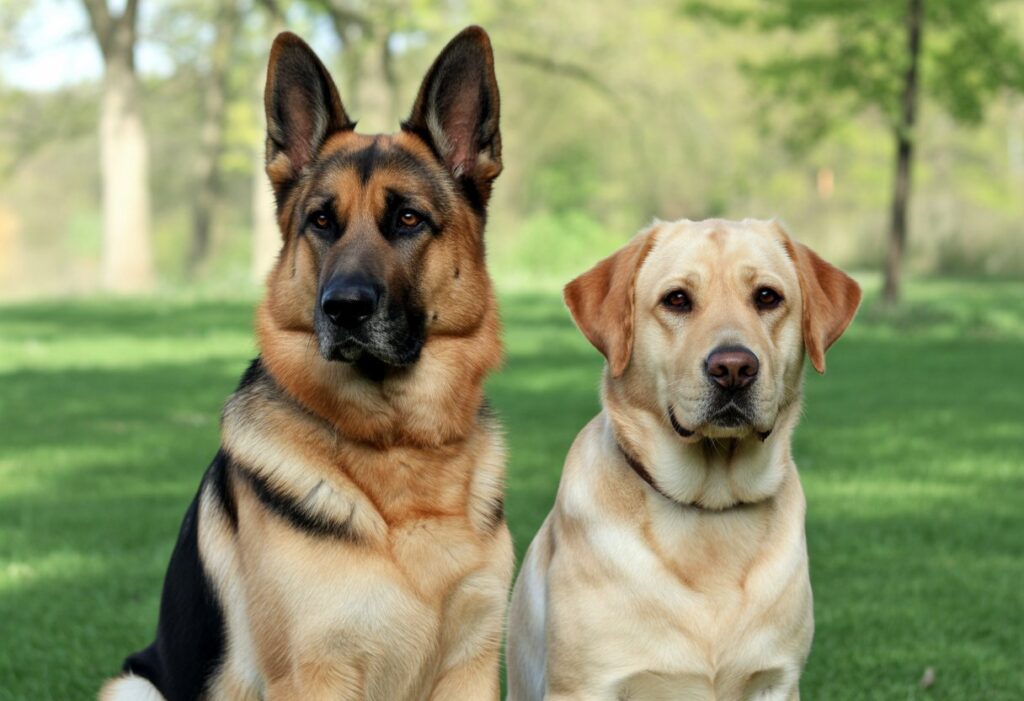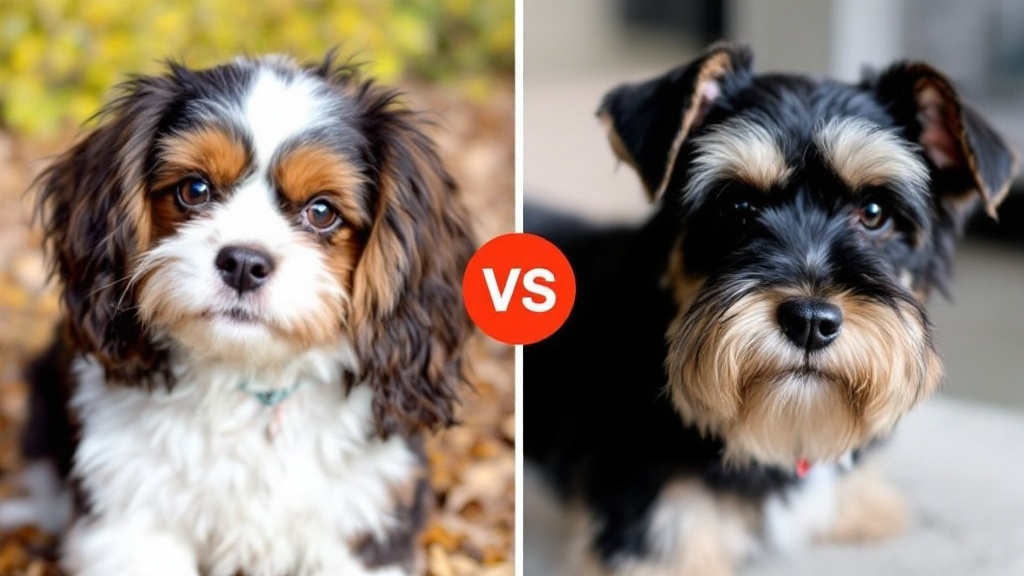Choosing between a German Shepherd and a Labrador Retriever can be tough, especially if you want a family dog or a loyal companion. Both breeds are popular for their intelligence, energy, and loving nature, but they have clear differences in temperament, appearance, and needs. Understanding these differences will help you decide which breed is right for you.

German Shepherds are often seen as hardworking dogs with a strong sense of duty. Labradors are friendly, outgoing, and tend to get along well with children and other pets. Both have unique strengths, but your lifestyle and what you expect from a dog will play a big role in your choice.
Whether you’re looking for a playful friend or a protective partner, knowing how German Shepherds and Labradors compare in areas like training, exercise, and care can make your decision much easier.
Breed Origins and History

German Shepherds and Labrador Retrievers come from different backgrounds, shaped by work and companionship. Their histories explain their personalities, strengths, and differences as purebred dog breeds.
German Shepherd Background
The German Shepherd started in Germany in the late 1800s. Captain Max von Stephanitz wanted a smart, strong working dog to herd sheep and protect farms. He mixed various herding dogs from different German regions to make the first German Shepherd.
These dogs soon became famous for their intelligence and loyalty. Police and military groups noticed their skills and started using them for protection, search-and-rescue, and service work. The German Shepherd is now one of the most recognized dog breeds worldwide.
Their heritage as workers makes them both energetic and eager to please. This background also helps explain why German Shepherds are often used in jobs that need focus and courage.
Labrador Retriever Heritage
The Labrador Retriever traces its roots to Newfoundland, Canada, in the 1800s. Fishermen used a breed called the St. John’s dog to help retrieve nets and fish from cold water. British nobles noticed these dogs and took some back to England.
In England, careful breeding shaped the Labrador Retriever you know today. The breed became popular as a gun dog for hunting waterfowl because of its gentle mouth, swimming skill, and friendly nature. This purebred dog is known for being easy to train and good with families.
Labradors quickly became one of the top breeds in the United States and the United Kingdom. Today, they stand out as a popular choice for guide dogs and service work.
Development of Popular Dog Breeds
Many popular dog breeds developed for specific tasks, such as herding, hunting, or guarding. Breeders chose traits to match the jobs people needed done, leading to clear differences in personality and looks.
Both German Shepherds and Labrador Retrievers are purebred dogs, but their backgrounds reflect different types of work. German Shepherds excel at herding and protection, while Labradors are skilled retrievers built for water and companionship.
You can see how the purpose behind breeding shapes not just behavior but also physical abilities. This history affects how these breeds fit into modern homes, families, and workplaces.
Physical Characteristics

German Shepherds and Labrador Retrievers have many differences in their bodies, coats, and strengths. Knowing these traits helps you understand what to expect from each breed.
Size and Appearance
German Shepherds are usually a bit taller and longer than Labradors. A typical German Shepherd stands 22 to 26 inches at the shoulder and weighs 50 to 90 pounds. Labradors, known as Yellow Lab when referencing the yellow color, are usually 21.5 to 24.5 inches tall and weigh 55 to 80 pounds.
German Shepherds have a more angular face and a longer, bushy tail. Their ears stand up, giving them an alert look. Labs have a broader skull, a shorter muzzle, and large, floppy ears. Their tail is thick and often called an “otter tail.”
You will often notice the differences right away just by looking at the outline and head shape. Both breeds look athletic, but the German Shepherd appears more alert and the Labrador more friendly.
Coat Color and Type
German Shepherds have a double coat that feels dense and straight. The outer coat is often medium length, and the undercoat is soft. Their colors can be black and tan, sable, solid black, or even white.
Labrador Retrievers have a short, straight, weather-resistant double coat. Their coats come in three solid colors: black, yellow (this is the famous Yellow Lab), and chocolate. The coat on a Lab is generally softer and shorter than that of a German Shepherd.
Labs shed year-round, but German Shepherds are known for heavier seasonal shedding. Both need regular brushing to help with loose hair and keep their coats healthy, but you might notice more fur around your home with a German Shepherd.
Strength and Build
German Shepherds are known for their strong, muscular build and are used often in police or military work. They belong to the Herding Group in dog competitions, showing their need for agility and stamina. Their back slopes down a bit toward the tail, which is part of their working-dog heritage.
Labrador Retrievers are strong as well, with broad chests and powerful legs, but their bodies are more compact. They are bred to retrieve and swim, so their muscles focus on endurance and movement in water. While not as angular as a German Shepherd, a Lab’s build is heavy and sturdy.
Both breeds are physically strong, but the German Shepherd has more visible muscle definition, while the Lab is solid and balanced. You can count on both for athletic and energetic play.
Temperament and Personality

Both German Shepherds and Labrador Retrievers are known for being loyal, intelligent, and excellent family dogs. However, there are several key differences that may help you decide which breed fits you best.
Loyalty and Social Traits
German Shepherds are extremely loyal and often form strong bonds with one person or family. They are protective and can be reserved around strangers. This makes them excellent as guard dogs.
Labrador Retrievers are also loyal but tend to be more social with everyone they meet. Labs are known to greet strangers with a wagging tail. They thrive in homes with lots of visitors or active families.
Both breeds do well with children and other pets when socialized early. If you want a loyal companion who also welcomes new friends, a Labrador may be best. If your focus is on protection and loyalty, a German Shepherd stands out.
Intelligence and Trainability
German Shepherds rank among the most intelligent dog breeds. They learn new commands quickly and excel in activities like obedience and agility. Their intelligence is a key reason they are used as police or service dogs.
Labrador Retrievers are also smart and are known for being eager to please. Their friendly nature makes them easy to train, even for first-time dog owners. Labs respond well to positive reinforcement.
Here is a quick comparison in a table:
| Trait | German Shepherd | Labrador Retriever |
|---|---|---|
| Learns Quickly | ✔️ | ✔️ |
| Obedience Stars | ✔️ | ✔️ |
| Service Work | ✔️ | ✔️ |
| Training Needs | High | Medium |
Both breeds enjoy mental challenges, but Shepherds sometimes need more structured training to channel their energy positively.
Independence and Adaptability
German Shepherds can be more independent than Labs. They are able to spend time alone without becoming anxious, but they still need daily interaction with you to stay happy.
Labrador Retrievers adapt well to many situations but tend to need more attention from their families. Labs do not like being left alone for long periods and can develop separation anxiety.
If you have a busy schedule or need a dog that can handle some alone time, think about a German Shepherd. If you want a companion dog who is happiest by your side, a Labrador Retriever suits that role.
Cheerful and Companionable Nature
Labrador Retrievers are often described as cheerful and outgoing. Their playful attitude and friendly spirit make them favorites among dog lovers. Labs are eager to join in activities, play with children, and offer affection.
German Shepherds are more serious but still enjoy spending time with their families. They can be affectionate and enjoy playtime, but their focus is often on their role as a protector and loyal partner.
If you want a dog that is always eager to play and join the fun, a Lab is a natural choice. If you prefer a more reserved, yet deeply companionable family pet, a German Shepherd fits that role. Both breeds make excellent family pets with the right care and training.
Exercise and Activity Requirements

German Shepherds and Labrador Retrievers are both very active breeds. They require plenty of exercise and mental stimulation to stay healthy and happy.
Daily Exercise Needs
A German Shepherd needs at least 90 minutes of exercise each day. This can include long walks, playing fetch, or running. German Shepherds have high energy and can get bored if not given enough to do.
A Labrador Retriever also needs about 60 to 90 minutes daily. Labradors love to play outside and enjoy games like fetch or frisbee. They are prone to weight gain if they miss regular activity.
You should try to split exercise into two or more sessions a day. Without enough physical and mental activity, both breeds may develop behavior problems like chewing or barking. Unlike Beagles, which need less intense exercise, both German Shepherds and Labradors thrive with more active routines.
Suitability for Activities
German Shepherds are often used as working dogs, excelling in activities that require focus and obedience. They do well in agility training, obedience, and protection work. Many German Shepherds enjoy jobs that keep them busy, making them good choices for families who want a training partner.
Labrador Retrievers are known for being friendly and easygoing, making them great for family games, therapy work, and hunting. Labs excel at retrieving, hiking, and scent-based games. They are not as intense as a Border Collie or Australian Shepherd, but are still versatile and energetic.
Both breeds are good choices if you like outdoor hobbies and interactive games. They are not lazy dogs and will not be satisfied with short walks or just a quick game of tug.
Swimming Abilities
Labrador Retrievers are strong natural swimmers. Their webbed paws and water-resistant coat make swimming easy and enjoyable for them. Labs are often used in water rescue and hunting waterfowl.
German Shepherds can also swim, but they are not as naturally skilled in the water as Labradors. Some may like swimming, but others need gentle introduction and encouragement. Supervise your German Shepherd near water, especially at first.
Swimming is a low-impact way to exercise both dogs, especially in hot weather. If you have a pool or visit lakes often, a Labrador may take to water more quickly and confidently than a German Shepherd.
Trainability and Obedience
German Shepherds and Labrador Retrievers are both smart breeds, but their personalities shape how they respond to training. Each breed also has a strong history in working and service roles that affect their training needs and challenges.
Obedience Training Methods
German Shepherds are known for their sharp focus and fast learning in obedience training. They respond best to consistent, reward-based methods paired with clear commands. You should start with short, regular sessions to keep them engaged, as they can become bored with repetition.
Labrador Retrievers are eager to please and love positive attention. They respond especially well to treats, praise, and toys as rewards. Labradors may be a bit more excitable than German Shepherds, so you’ll want to use patience and stay calm.
Both breeds benefit from early socialization and basic obedience classes. Regular training is key, but Labradors might need gentle reminders to stay on task, while German Shepherds may need variety to prevent stubbornness or overprotectiveness.
Role in Working and Service
German Shepherds are often trained as police, military, and search-and-rescue dogs. Their intelligence, loyalty, and ability to follow complex commands make them a top choice for many jobs. In military roles, German Shepherds can learn advanced skills like tracking, detection, and protection work.
Labradors are widely used as guide dogs, therapy dogs, and detection dogs. Their calm, friendly nature and reliable obedience help them succeed in public settings. Labs also do well in service work for people with disabilities because they are gentle and patient.
| Role | German Shepherd | Labrador Retriever |
|---|---|---|
| Police/Military | Common | Rare |
| Guide Dog | Less Common | Very Common |
| Detection Work | Common | Common |
| Therapy | Some | Very Common |
Both breeds are highly valued as working dogs, but they are assigned to different jobs based on their personalities and strengths.
Challenges in Training
Training a German Shepherd can be challenging if you are not confident or consistent. They are quick to notice inconsistency in rules or commands, which may lead to stubborn behavior. Without enough mental stimulation, they can develop habits like barking, chewing, or guarding.
Labradors may get distracted, especially when young. Their high energy and excitement can lead them to ignore commands in new or distracting environments. You may need extra patience during the puppy stage, as Labs like to test boundaries with playful behavior.
Both dogs need regular exercise, mental challenges, and daily structure to succeed in training. Lack of engagement or boredom makes training harder, especially for intelligent breeds like German Shepherds and Labradors.
Health and Lifespan
German Shepherds and Labrador Retrievers are popular purebred dogs with different health profiles. Both breeds need attention to preventive care, but you should know their most common health risks and life expectancy to make informed decisions.
Common Health Issues
German Shepherds are prone to hip and elbow dysplasia, which can cause joint pain and mobility problems. Degenerative myelopathy, a progressive spinal disease, is also seen in this breed. They may experience digestive issues like bloat and are sometimes at risk for allergies and skin problems.
Labrador Retrievers often struggle with obesity if not properly exercised and fed. They can also develop hip and elbow dysplasia, but are less likely to get spinal diseases. Labs may be affected by eye disorders like progressive retinal atrophy, and are at risk for ear infections due to their floppy ears.
Mixed breed dogs tend to have fewer inherited health problems but can still inherit conditions from their parent breeds. Regular checkups and early diagnosis are important for all dogs.
| Health Issue | German Shepherd | Labrador Retriever |
|---|---|---|
| Hip/Elbow Dysplasia | Common | Common |
| Degenerative Myelopathy | Can occur | Rare |
| Obesity | Less common | Common |
| Eye Disorders | Sometimes | Common |
| Ear Infections | Less common | Common |
Average Lifespan
German Shepherds usually live 9 to 13 years. Larger dogs tend to have shorter lifespans, and health challenges like joint problems may reduce their years if not managed.
Labrador Retrievers typically live 10 to 14 years. Good diet and regular exercise help them reach the upper end of this range. Obesity can shorten a Lab’s life if left unchecked.
Mixed breed dogs often enjoy similar or slightly longer lifespans than their purebred parents. Hereditary issues may be less severe in mixed breeds, but this is not always true.
| Breed | Average Lifespan |
|---|---|
| German Shepherd | 9-13 years |
| Labrador Retriever | 10-14 years |
| Mixed Breed (related) | 10-15 years |
Maintenance and Care
You should schedule yearly veterinary checkups for early detection of health problems in both breeds. Vets may recommend X-rays or genetic tests, especially for German Shepherds, to monitor joint and spine health.
Labs often need regular ear cleaning to prevent infections, while German Shepherds benefit from joint supplements as they age. Weight management is critical for both dogs, especially Labradors, which can quickly gain extra pounds.
Proper exercise, a balanced diet, and flea and tick prevention help your dog stay healthy. Clean your dog’s teeth regularly to avoid dental issues, no matter which breed you choose. Mixed breed dogs need the same care and attention as purebreds.
Suitability as Family Dogs
German Shepherds and Labrador Retrievers are both popular family pets. Each breed brings different traits for families, kids, and other household animals. Their behavior at home and with others shows why they are often chosen as companion dogs.
Interactions with Children
Labrador Retrievers are known for their gentle and patient attitude with children. They are playful but rarely aggressive, making them a safe choice for young families. Labs usually love attention, can handle loud noises, and do not mind being hugged or handled by kids.
German Shepherds are also good with children, but they tend to be more protective. This can make them great watchdogs, but some Shepherds might be wary of rough play or strangers visiting the house. Socialization from a young age helps a German Shepherd puppy get used to kids and their energy levels.
Both breeds need supervision when first introduced to young children. Teaching kids how to approach and treat dogs with respect is important for safety. German Shepherds are bigger and stronger, so roughhousing should be avoided. Both breeds can do well with kids with the right training and oversight.
Compatibility with Other Pets
Labrador Retrievers are usually friendly with other pets, including cats and other dogs. Their easy-going nature helps them fit well into multi-pet homes. Labs enjoy group play and are less likely to show dominant behaviors.
German Shepherds can get along with other pets, but their herding and guarding instincts may lead them to chase small animals or act territorial. Early socialization helps reduce unwanted behaviors. Shepherds may take longer to accept new pets, especially if not introduced while young.
If you already have pets, a Labrador Retriever will likely require less effort to settle in. List of common pet compatibility needs:
- Early socialization
- Supervised first introductions
- Consistent rules for behaviors
Adaptation to Home Life
Labrador Retrievers are adaptable and do well in houses with a yard, but many thrive in apartments if given enough daily exercise. Labs enjoy being part of family activities and rarely like being left alone for long periods.
German Shepherds need both physical and mental stimulation. They do best in homes where someone is present most of the time. A German Shepherd may become bored or destructive if left alone without enough activity or attention.
Both breeds shed, but German Shepherds need a bit more regular grooming. Setting routines helps both breeds adjust better to household life. They need space, clear boundaries, and a regular exercise schedule to stay healthy and happy as companion dogs.
Comparison with Similar Breeds
Some breeds share traits with German Shepherds and Labradors, but key differences set them apart. Things like temperament, trainability, and energy level are important for choosing the right breed for your lifestyle.
German Shepherd vs Golden Retriever
German Shepherds and Golden Retrievers are both large, loyal, and intelligent dogs. German Shepherds are often more protective and reserved, which makes them good guard dogs and working dogs. Golden Retrievers are social, gentle, and friendly with almost everyone.
Golden Retrievers are easier for first-time dog owners because they usually want to please and are less stubborn. They shed a lot and need brushing, just like German Shepherds. Goldens love family time and being with kids but are not as suspicious of strangers.
If you need a watchful, focused dog, a German Shepherd is a better choice. For a playful, relaxed family companion, a Golden Retriever may suit you more.
| Trait | German Shepherd | Golden Retriever |
|---|---|---|
| Temperament | Protective, loyal | Friendly, gentle |
| Energy Level | High | High |
| Shedding | Heavy | Heavy |
| Best For | Guarding, working | Family, therapy |
Labrador Retriever vs Bulldog
Labradors and Bulldogs (like the English Bulldog) have very different personalities and care needs. Labradors are active, eager to play, and require a lot of exercise. They need walks and games every day to stay healthy.
Bulldogs are much calmer and lower energy. They prefer short walks and lots of naps. Bulldogs are friendly but can be stubborn when training. Their short noses mean breathing problems in hot weather so you need to be careful with exercise.
Labradors are usually a better fit if you want a running buddy or a dog for outdoor fun. Bulldogs are ideal if you like a laid-back companion who enjoys relaxing at home.
| Trait | Labrador Retriever | Bulldog (English) |
|---|---|---|
| Energy Level | High | Low |
| Temperament | Outgoing, eager | Calm, gentle |
| Trainability | High | Moderate |
| Lifespan | 10-12 years | 8-10 years |
Comparison with Border Collie and Belgian Malinois
Border Collies and Belgian Malinois are other breeds known for intelligence and work drive. Border Collies are famous for their herding skills and high energy. They need activities like agility, frisbee, or advanced training to stay happy. This breed learns quickly but isn’t as protective as German Shepherds.
Belgian Malinois are close to German Shepherds in looks and energy. They are used for police and military jobs because they focus well and learn fast. Malinois are very loyal, but they need constant mental and physical activity.
If you want a dog that loves to work and has lots of stamina, Belgian Malinois or Border Collie might be a good fit. Both need experienced owners who can provide training and structure.
| Breed | Best Known For | Energy Level | Suitability |
|---|---|---|---|
| Border Collie | Herding/intelligence | Very High | Active, skilled owners |
| Belgian Malinois | Police/military work | Very High | Advanced handlers |
| German Shepherd | Versatility/loyalty | High | Working, active families |
Popularity and Roles in Society
Both the German Shepherd and Labrador Retriever are widely recognized for their intelligence and versatility. Each breed has earned its place in society, from being top family pets to taking on important jobs.
Most Popular Dog Breeds
The Labrador Retriever has been the most popular dog breed in America for many years, according to the American Kennel Club (AKC). Families often choose Labs because they are friendly, outgoing, and easy to train.
German Shepherds also rank high on the popularity list, usually appearing in the top five. They are known for their loyalty and protectiveness. German Shepherds can be a bit more reserved with strangers but are extremely devoted to their families.
Many people choose these breeds for their intelligence, energy, and ability to learn new skills. You are likely to see both breeds often at parks, in homes, and on social media.
| Rank (AKC 2024) | Labrador Retriever | German Shepherd |
|---|---|---|
| Popularity Ranking | #1 | #4 |
Working and Service Roles
German Shepherds are famous working dogs. Police, military, and security agencies often use them for patrol, search and rescue, and detection work. Their courage and alertness make them ideal for these tasks.
Labrador Retrievers are commonly chosen as service dogs. They assist people with disabilities, work as therapy dogs, and serve in search and rescue missions. Labs have a gentle nature and strong sense of smell, which helps them in these jobs.
Both breeds are highly trainable. You will see them as guide dogs for the blind, assistance dogs, drug detection dogs, and even search and rescue animals. Their skills make them valuable in many areas of society.
Cultural Impact and Representation
Labrador Retrievers often appear in movies, TV shows, and books as friendly, family-oriented pets. Their image is one of playfulness and warmth, which makes them a favorite in popular culture.
German Shepherds are commonly shown as loyal, brave, and protective. They are featured in stories about police and military work, like the famous TV show “Rin Tin Tin.” Their reputation as guardians makes them stand out.
Both breeds symbolize qualities like loyalty and intelligence. You are likely to find their images used in advertisements, public service campaigns, and even logos for security or service organizations. These dogs continue to shape how society views working and family pets.
Choosing Between German Shepherd and Labrador Retriever
German Shepherds and Labradors both have unique traits. Their exercise needs, temperament, and care can shape your daily life in different ways.
Factors to Consider
German Shepherds are known for loyalty, intelligence, and protective instincts. They often do well with focused training and jobs to do. This breed is active, alert, and sometimes reserved with strangers.
Labrador Retrievers are very friendly and social. They are outgoing, quick to trust, and love spending time with people and other dogs. Labs rarely show aggression, making them good with families and children.
Think about your living space too. German Shepherds may need secure yards. Labradors can adapt well to apartments if they receive enough daily walks. Both breeds shed, but German Shepherds require more grooming due to their double coat.
Best Fit for Lifestyle
If you enjoy outdoor activities like hiking or running, both breeds will enjoy joining you. However, German Shepherds may suit you better if you want a dog for training, service, or as a watchdog. They thrive when given tasks or a sense of duty.
Labradors make excellent companion dogs. If you have young kids or want a playful, easygoing pet, a Lab is a great choice. Labs are popular with dog lovers as therapy and assistance dogs for their friendly nature.
If your lifestyle is busy or you are a first-time owner, Labs are usually easier to handle. German Shepherds need an owner ready to provide firm training and lots of mental stimulation.
Long-Term Commitment
Lifespan and health:
| Breed | Average Lifespan | Common Health Issues |
|---|---|---|
| German Shepherd | 9-13 years | Hip dysplasia, arthritis |
| Labrador Retriever | 10-12 years | Hip dysplasia, obesity |
Both breeds can live a decade or longer. You must prepare for vet visits, grooming, and exercise for many years.
Labradors sometimes get overweight, so portion control and regular exercise are important. German Shepherds need early and ongoing socialization to avoid behavior problems.
Mixed breed dogs can offer some advantages, such as fewer genetic health issues and unique personalities, but require the same level of care and attention as purebreds.
Owning either breed is a long-term responsibility. Your daily routines will need to include exercise, feeding, and time for your dog’s social and emotional needs.



